Exploring the Mass Concentration of Particulate Matter and Its Relationship with Meteorological Parameters in the Hindu-Kush Range
Abstract
:1. Introduction
2. Materials and Methods
2.1. Research Area and Its Meteorological Conditions
2.2. Sample Collections
2.3. Linear Regression Analysis
3. Results and Discussion
3.1. Monthly and Seasonal Variation in PM10, PM2.5, and PM1 Mass Concentration
3.2. Relation between PM10, PM2.5, and PM1
3.3. Correlation between PM10, PM2.5, and PM1 Concentrations with Meteorological Parameters
3.4. Emission Sources
4. Conclusions
Author Contributions
Funding
Institutional Review Board Statement
Informed Consent Statement
Data Availability Statement
Acknowledgments
Conflicts of Interest
References
- Tian, G.; Qiao, Z.; Xu, X. Characteristics of particulate matter (PM10) and its relationship with meteorological factors during 2001–2012 in Beijing. Environ. Pollut. 2014, 192, 266–274. [Google Scholar] [CrossRef]
- Pope, C.A., III; Burnett, R.T.; Thun, M.J.; Calle, E.E.; Krewski, D.; Ito, K.; Thurston, G.D. Lung cancer, cardiopulmonary mortality, and long-term exposure to fine particulate air pollution. JAMA 2002, 287, 1132–1141. [Google Scholar] [CrossRef] [PubMed] [Green Version]
- Churg, A.; Brauer, M.; del Carmen Avila-Casado, M.; Fortoul, T.I.; Wright, J.L. Chronic exposure to high levels of particulate air pollution and small airway remodeling. Environ. Health Perspect. 2003, 111, 714–718. [Google Scholar] [CrossRef] [Green Version]
- Rivero, D.H.; Soares, S.R.; Lorenzi-Filho, G.; Saiki, M.; Godleski, J.J.; Antonangelo, L.; Dolhnikoff, M.; Saldiva, P.H. Acute cardiopulmonary alterations induced by the fine particulate matter of Sao Paulo, Brazil. Toxicol. Sci. 2005, 85, 898–905. [Google Scholar] [CrossRef] [Green Version]
- Hoek, G.; Raaschou-Nielsen, O. Impact of fine particles in ambient air on lung cancer. Chin. J. Cancer 2014, 33, 197. [Google Scholar] [CrossRef]
- Chen, M.J.; Yang, P.H.; Hsieh, M.T.; Yeh, C.H.; Huang, C.H.; Yang, C.M.; Lin, G.M. Machine learning to relate PM2.5 and PM10 concentrations to outpatient visits for upper respiratory tract infections in Taiwan: A nationwide analysis. World J. Clin. 2018, 6, 200. [Google Scholar] [CrossRef] [PubMed]
- He, Y.; Gao, Z.; Guo, T.; Qu, F.; Liang, D.; Li, D.; Shi, J.; Shan, B. Fine particulate matter associated mortality burden of lung cancer in Hebei Province, China. Thorac. Cancer 2018, 9, 820–826. [Google Scholar] [CrossRef] [PubMed]
- Huang, F.; Zhao, Y.; Wang, P.; Wang, Y.; Zhang, L.; Luo, Y. Short-term exposure to particulate matter on heart rate variability in humans: A systematic review of crossover and controlled studies. Environ. Sci. Pollut. Res. 2021, 28, 35528–35536. [Google Scholar] [CrossRef]
- Choi, E.; Yi, S.M.; Lee, Y.S.; Jo, H.; Baek, S.O.; Heo, J.B. Sources of airborne particulate matter-bound metals and spatial-seasonal variability of health risk potentials in four large cities, South Korea. Environ. Sci. Pollut. Res. 2022, 29, 28359–28374. [Google Scholar] [CrossRef] [PubMed]
- Villanueva, F.; Tapia, A.; Cabañas, B.; Martínez, E.; Albaladejo, J. Characterization of particulate polycyclic aromatic hydrocarbons in an urban atmosphere of central-southern Spain. Environ. Sci. Pollut. Res. 2015, 22, 18814–18823. [Google Scholar] [CrossRef]
- Zeb, B.; Alam, K.; Ditta, A.; Ullah, S.; Ali, H.M.; Ibrahim, M.; Salem, M.Z.M. Variation in coarse particulate matter (PM10) and its characterization at multi-locations in the semiarid region. Front. Environ. Sci. 2022, 10, 843582. [Google Scholar] [CrossRef]
- Vautard, R.; Builtjes, P.H.; Thunis, P.; Cuvelier, C.; Bedogni, M.; Bessagnet, B.; Honore, C.; Moussiopoulos, N.; Pirovano, G.; Schaap, M.; et al. Evaluation and intercomparison of Ozone and PM10 simulations by several chemistry-transport models over four European cities within the City Delta project. Atmos. Environ. 2007, 41, 173–188. [Google Scholar] [CrossRef]
- Saliba, N.A.; El Jam, F.; El Tayar, G.; Obeid, W.; Roumie, M. Origin and variability of particulate matter (PM10 and PM2.5) mass concentrations over an Eastern Mediterranean city. Atmos. Res. 2010, 97, 106–114. [Google Scholar] [CrossRef]
- Kong, H.K.; Yoon, D.K.; Lee, H.W.; Lee, C.M. Evaluation of particulate matter concentrations according to cooking activity in a residential environment. Environ. Sci. Pollut. Res. 2021, 28, 2443–2456. [Google Scholar] [CrossRef]
- Katsouyanni, K.; Toulomi, G.; Samoli, G.; Gryparis, A.; LeTertre, A.; Monopolis, Y. Confounding and effect modification in the short-term effects of ambient particles on total mortality: Results from 29 European cities within the APAEA2 project. Epidemiology 2001, 12, 521–533. [Google Scholar] [CrossRef] [Green Version]
- Dockery, D.W.; Pope, C.A., III; Xu, X.; Spengler, J.D.; Ware, J.H.; Martha, E.F.; Ferris, B.G.; Dominici, F.; McDermott, A.; Daniels, M.; et al. Revised analyses of the national morbidity, mortality and air pollution study: Mortality among residents of 90 cities. J. Toxicol. Environ. Health Part A 2005, 68, 1071–1092. [Google Scholar]
- Lim, J.M.; Lee, J.H.; Moon, J.H.; Chung, Y.S.; Kim, K.H. Source apportionment of PM10 at a small industrial area using positive matrix factorization. Atmos. Res. 2010, 95, 88–100. [Google Scholar] [CrossRef]
- Makkonen, U.; Hellén, H.; Anttila, P.; Ferm, M. Size distribution and chemical composition of airborne particles in south-eastern Finland during different seasons and wildfire episodes in 2006. Sci. Total Environ. 2010, 408, 644–651. [Google Scholar] [CrossRef] [PubMed]
- Camargo Pires-Neto, R.; Julia Lichtenfels, A.; Regina Soares, S.; Macchione, M.; Hilario Nascimento Saldiva, P.; Dolhnikoff, M. Effects of Sao Paulo air pollution on the upper airways of mice. Environ. Res. 2006, 101, 356–361. [Google Scholar] [CrossRef]
- Cendon, S.; Pereira, L.A.; Braga, A.L.; Conceição, G.; Cury Junior, A.; Romaldini, H.; Lopes, A.C.; Saldiva, P.H. Air pollution effects on myocardial infarction. Rev. Saude Publica 2006, 40, 414–419. [Google Scholar] [CrossRef] [Green Version]
- Furuta, N.; Lijima, A.; Kambe, A.; Sakai, K.; Sato, K. Concentrations enrichment and predominant sources of Sb and other trace elements in size classified airborne particulate matter collected in Tokyo from 1995 to 2004. J. Environ. Monit. 2005, 7, 1155–1161. [Google Scholar] [CrossRef]
- Tiwari, S.; Bisht, D.S.; Srivastava, A.K.; Pipal, A.S.; Taneja, A.; Srivastava, M.K.; Attri, S.D. Variability in atmospheric particulates and meteorological effects on their mass concentrations over Delhi, India. Atmos. Res. 2014, 145, 45–56. [Google Scholar] [CrossRef]
- Munir, S.; Habeebullah, T.M.; Seroji, A.R.; Morsy, E.A.; Mohammed, A.M.F.; Saud, W.A.; Esawee, A.L.; Awad, A.H. Modeling particulate matter concentrations in Makkah, applying a statistical modeling approach. Aerosol Air Qual. Res. 2013, 13, 901–910. [Google Scholar] [CrossRef] [Green Version]
- Khodeir, M.; Shamy, M.; Alghamdi, M.; Zhong, M.; Sun, H.; Costa, M.; Chen, L.C.; Maciejcczyk, P.M. Source apportionment and elemental composition of PM2.5 and PM10 in Jeddah City, Saudi Arabia. Atmos. Pollut. Res. 2012, 3, 331–340. [Google Scholar] [CrossRef] [PubMed] [Green Version]
- Munir, S.; Habeebullah, T.M.; Mohammed, A.M.; Morsy, E.A.; Rehan, M.; Ali, K. Analyzing PM2.5 and its association with PM10 and meteorology in the arid climate of Makkah, Saudi Arabia. Aerosol Air Qual. Res. 2017, 17, 453–464. [Google Scholar] [CrossRef]
- Hien, P.D.; Bac, V.T.; Tham, H.C.; Nhan, D.D.; Vinh, L.D. Influence of meteorological conditions on PM2.5 and PM2.5−10 concentrations during the monsoon season in Hanoi, Vietnam. Atmos. Environ. 2002, 36, 3473–3484. [Google Scholar] [CrossRef]
- Laakso, L.; Hussein, T.; Aarnio, P.; Komppula, M.; Hiltunen, V.; Viisanen, Y.; Kulmala, M. Diurnal and annual characteristics of particle mass and number concentrations in urban, rural and Arctic environments in Finland. Atmos. Environ. 2003, 37, 2629–2641. [Google Scholar] [CrossRef]
- Querol, X.; Alastuey, A.; Viana, M.M.; Rodriguez, S.; Artíñano, B.; Salvador, P.; Do Santos, S.G.; Patier, R.F.; Ruiz, C.R.; De la Rosa, J.; et al. Speciation and origin of PM10 and PM2.5 in Spain. Aerosol Sci. 2004, 35, 1151–1172. [Google Scholar] [CrossRef]
- Elminir, H.K. Dependence of urban air pollutants on meteorology. Sci. Total Environ. 2005, 350, 225–237. [Google Scholar] [CrossRef]
- Yang, L.X.; Wang, D.C.; Cheng, S.H.; Wang, Z.; Zhou, Y.; Zhou, X.H.; Wang, W.X. Influence of meteorological conditions and particulate matter on visual range impairment in Jinan, China. Sci. Total Environ. 2007, 383, 164–173. [Google Scholar] [CrossRef]
- Hogrefe, C.; Porter, P.S.; Gego, E.; Gilliland, A.; Gilliam, R.; Swall, J.; Irwin, J.; Rao, S.T. Temporal features in observed and simulated meteorology and air quality over the Eastern United States. Atmos. Environ. 2006, 40, 5041–5055. [Google Scholar] [CrossRef]
- Yadav, S.K.; Jain, M.K. Variation in concentrations of particulate matter with various sizes in different weather conditions in mining zone. Int. J. Environ. Sci. Technol. 2020, 17, 695–708. [Google Scholar] [CrossRef]
- Bibi, S.; Alam, K.; Chishtie, F.; Bibi, H.; Rahman, S. Temporal variation of Black Carbon concentration using Aethalometer observations and its relationships with meteorological variables in Karachi, Pakistan. J. Atmos. Sol. Terr. Phys. 2017, 157, 67–77. [Google Scholar] [CrossRef]
- Järvi, L.; Junninen, H.; Karppinen, A.; Hillamo, R.; Virkkula, A.; Mäkelä, T.; Pakkanen, T.; Kulmala, M. Temporal variations in black carbon concentrations with different time scales in Helsinki during 1996–2005. Atmos. Chem. Phys. 2008, 8, 1017–1027. [Google Scholar] [CrossRef] [Green Version]
- WHO. WHO Global Air Quality Guidelines: Particulate Matter (PM2.5 and PM10), Ozone, Nitrogen Dioxide, Sulfur Dioxide and Carbon Monoxide: Executive Summary 2021; WHO: Geneva, Switzerland, 2021. [Google Scholar]
- Li, Y.; Chen, Q.; Zhao, H.; Wang, L.; Tao, R. Variations in PM10, PM2.5, and PM1 in an urban area of the Sichuan Basin and their relation to meteorological factors. Atmosphere 2015, 6, 150–163. [Google Scholar] [CrossRef] [Green Version]
- Srimuruganandam, B.; Nagendra, S.M.S. Analysis and interpretation of particulate matter–PM10, PM2.5, and PM1 emissions from the heterogeneous traffic near an urban roadway. Atmos. Pollut. Res. 2010, 1, 184–194. [Google Scholar] [CrossRef] [Green Version]
- Chen, B.H.; Li, Y.Q. Relationships between air particle and meteorological elements in Chengdu. Urban Environ. Urban Ecol. 2006, 19, 18–20. [Google Scholar]
- Tao, J.; Zhang, L.; Engling, G.; Zhang, R.; Yang, Y.; Cao, J.; Zhu, C.; Wang, Q.; Luo, L. Chemical composition of PM2.5 in an urban environment in Chengdu, China: Importance of springtime dust storms and biomass burning. Atmos. Res. 2013, 122, 270–283. [Google Scholar] [CrossRef]
- Hu, M.; Liu, S.; Wu, Z.J. Effects of high temperature, high relative humidity and rain process on particle size distributions in the summer of Beijing. Environ. Sci. 2006, 27, 2293–2298. [Google Scholar]
- Tecer, L.H.; Süren, P.; Alagha, O.; Karaca, F.; Tuncel, G. Effect of meteorological parameters on fine and coarse particulate matter mass concentration in a coal-mining area in Zonguldak, Turkey. J. Air Waste Manag. Assoc. 2008, 58, 543–552. [Google Scholar] [CrossRef]
- Trinh, T.T.; Trinh, T.T.; Le, T.T.; Tu, B.M. Temperature inversion and air pollution relationship, and its effects on human health in Hanoi City, Vietnam. Environ. Geochem. Health 2019, 41, 929–937. [Google Scholar] [CrossRef] [PubMed]
- Deng, L.; Qian, J.; Liao, R.; Tong, H. Pollution characteristics of atmospheric particulates in Chengdu from August to September in 2009 and their relationship with meteorological conditions. China Environ. Sci. 2012, 32, 1433–1438. [Google Scholar]
- Zhao, H.; Che, H.; Ma, Y.; Xia, X.; Wang, Y.; Wang, P.; Wu, X. Temporal variability of the visibility, particulate matter mass concentration, and aerosol optical properties over an urban site in Northeast China. Atmos. Res. 2015, 166, 204–212. [Google Scholar] [CrossRef]
- Galindo, N.; Varea, M.; Gil-Moltó, J.; Yubero, E.; Nicolás, J. The influence of meteorology on particulate matter concentrations at an urban Mediterranean location. Water Air Soil Pollut. 2011, 215, 365–372. [Google Scholar] [CrossRef]
- Pateraki, S.; Asimakopoulos, D.N.; Flocas, H.A.; Maggos, T.; Vasilakos, C. The role of meteorology on different sized aerosol fractions (PM10, PM2.5, PM2.5–10). Sci. Total Environ. 2012, 419, 124–135. [Google Scholar] [CrossRef]
- Andersson, C.; Langner, J.; Bergstrom, R. Interannual variation and trends in air pollution over Europe due to climate variability during 1958–2001 simulated with a regional CTM coupled to the ERA40 reanalysis. Tellus. B Chem. Phys. Meteorol. 2006, 59, 77–98. [Google Scholar] [CrossRef] [Green Version]
- Kliengchuay, W.; Worakhunpiset, S.; Limpanont, Y.; Meeyai, A.C.; Tantrakarnapa, K. Influence of the meteorological conditions and some pollutants on PM10 concentrations in Lamphun, Thailand. J. Environ. Health Sci. Eng. 2021, 19, 237–249. [Google Scholar] [CrossRef] [PubMed]
- Lin, J.; Liu, W.; Yan, I. Relationship between meteorological conditions and particle size distribution of atmospheric aerosols. J. Meteorol. Environ. 2009, 25, 1–5. [Google Scholar]
- Larssen, S.; Barrett, K.; Adams, A.; Van het Bolscher, M.; de Leeuw, F.; Pulles, T.; van Loon, M.; van Pul, A. Air Pollution in Europe 1997–2004; Chemical Coordinating Centre of the European Monitoring and Evaluation Programme: Copenhagen, Denmark, 2007; p. 70. [Google Scholar]
- Shen, Z.Y.; Lu, B.; Chen, H.B. Effects of meteorology condition in precipitation on aerosol concentration in Zhengzhou. Meteorol. Environ. Sci. 2009, 32, 55–58. [Google Scholar]
- Charron, A.; Harrison, R.M. Primary particle formation from vehicle emissions during exhaust dilution in the roadside atmosphere. Atmos. Environ. 2003, 37, 4109–4119. [Google Scholar] [CrossRef]
- Caiyun, M.; Yueqing, T.; Yao, F. Effect analysis of meteorological factors on the inhalable particle matter concentration of atmosphere in Hami. Meteorol. Environ. Sci. 2011, 34, 75–79. [Google Scholar]
- Usman, F.; Zeb, B.; Alam, K.; Huang, Z.; Shah, A.; Ahmad, I.; Ullah, S. In-depth analysis of physicochemical properties of particulate matter (PM10, PM2.5 and PM1) and its characterization through FTIR, XRD and SEM–EDX Techniques in the Foothills of the Hindu Kush Region of Northern Pakistan. Atmosphere 2022, 13, 124. [Google Scholar] [CrossRef]
- Zeb, B.; Alam, K.; Sorooshian, A.; Blaschke, T.; Ahmad, I.; Shahid, I. On the morphology and composition of particulate matter in an urban environment. Aerosol Air Qual. Res. 2018, 18, 1431. [Google Scholar]
- Gugamsetty, B.; Wei, H.; Liu, C.N.; Awasthi, A.; Hsu, S.C.; Tsai, C.J.; Roam, G.D.; Wu, Y.C.; Chen, C.F. Source characterization and apportionment of PM10, PM2.5 and PM0.1 by using positive matrix factorization. Aerosol Air Qual. Res. 2012, 12, 476–491. [Google Scholar] [CrossRef]
- Lough, G.C.; Schauer, J.J.; Park, J.S.; Shafer, M.M.; Deminter, J.T.; Weinstein, J.P. Emissions of Metals associated with motor vehicle roadways. Environ. Sci. Technol. 2005, 39, 826–836. [Google Scholar] [CrossRef] [PubMed]
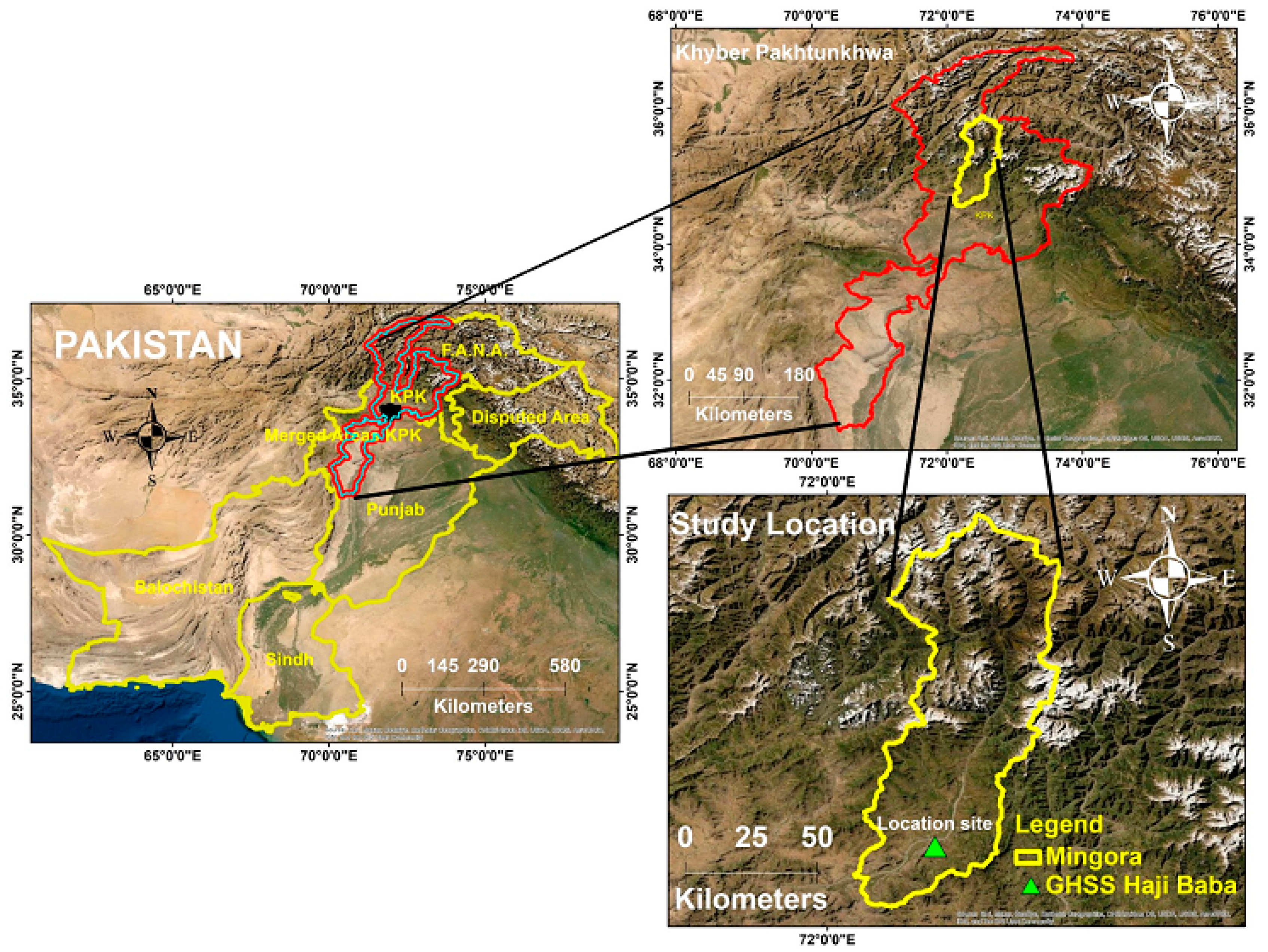
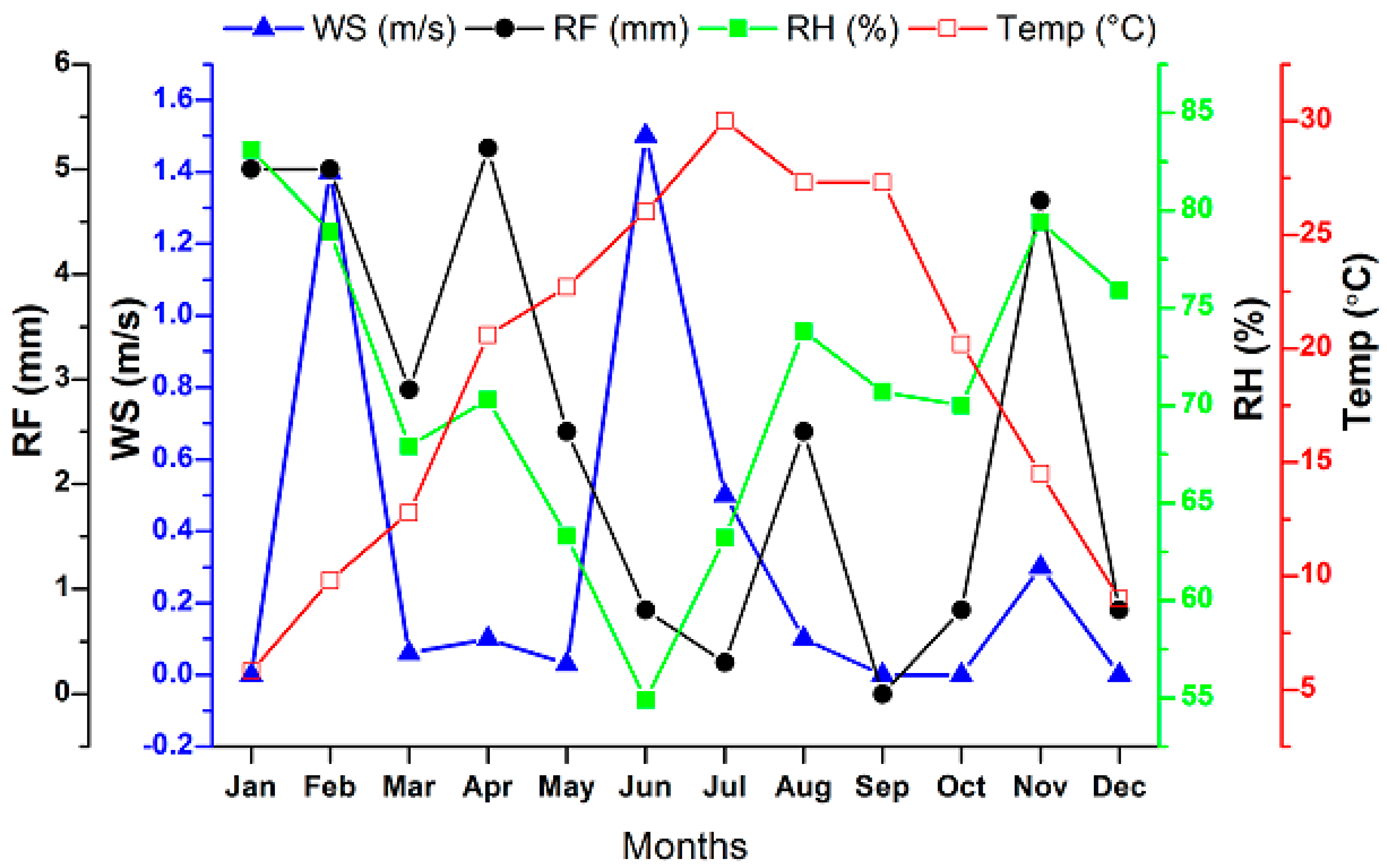

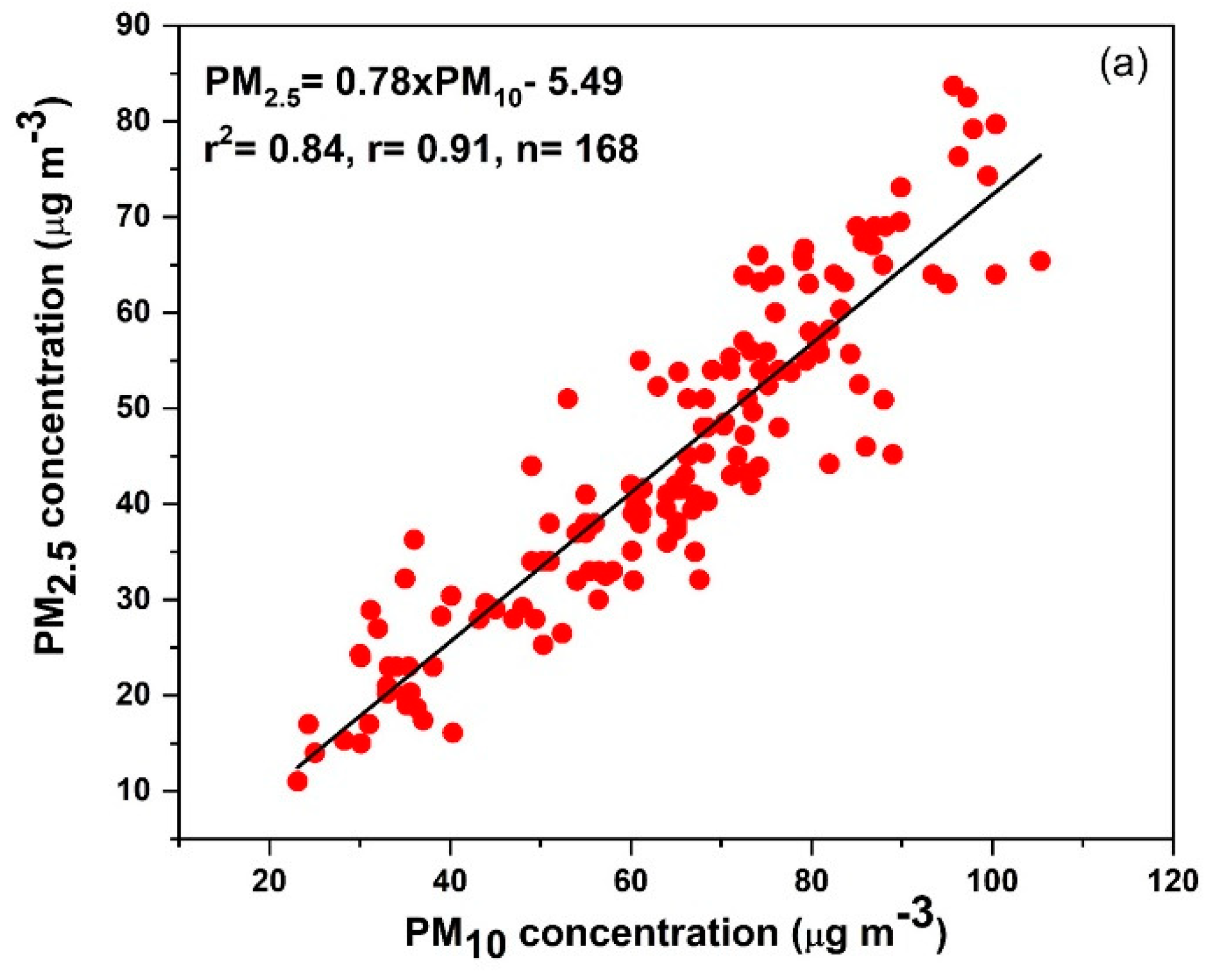
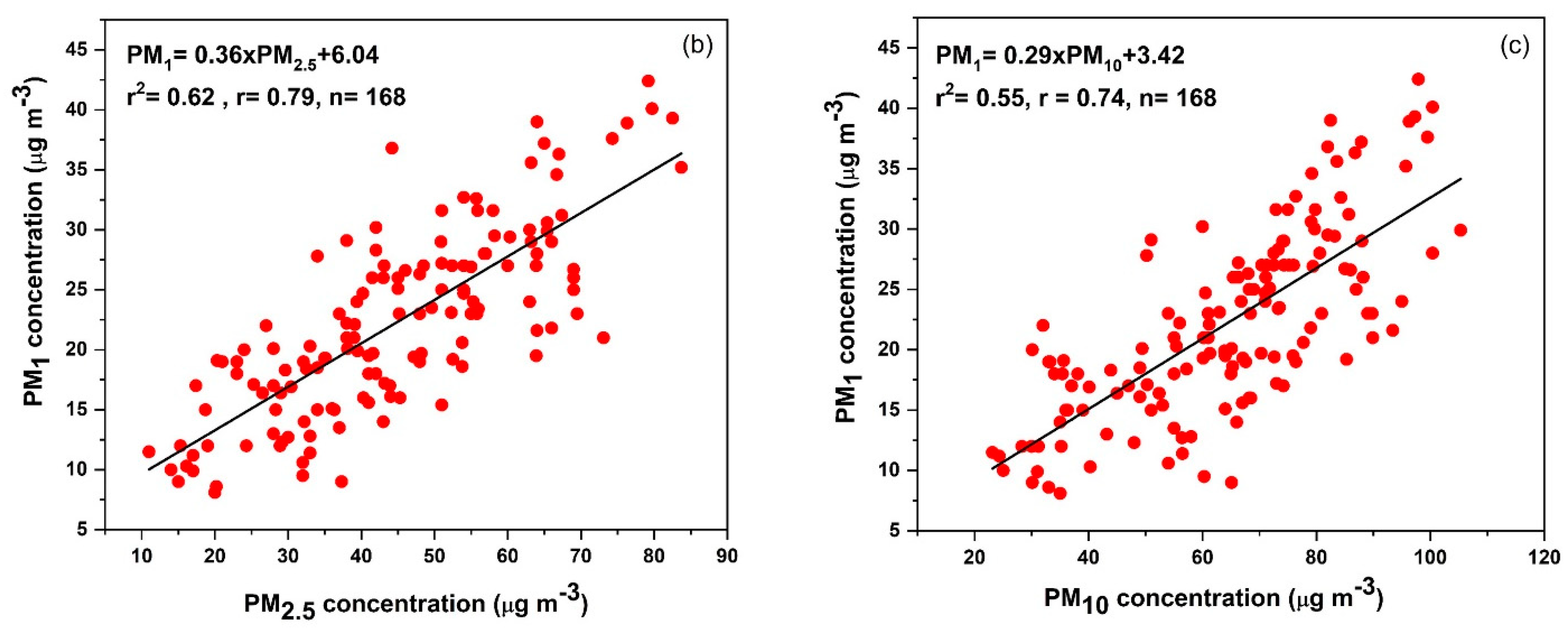
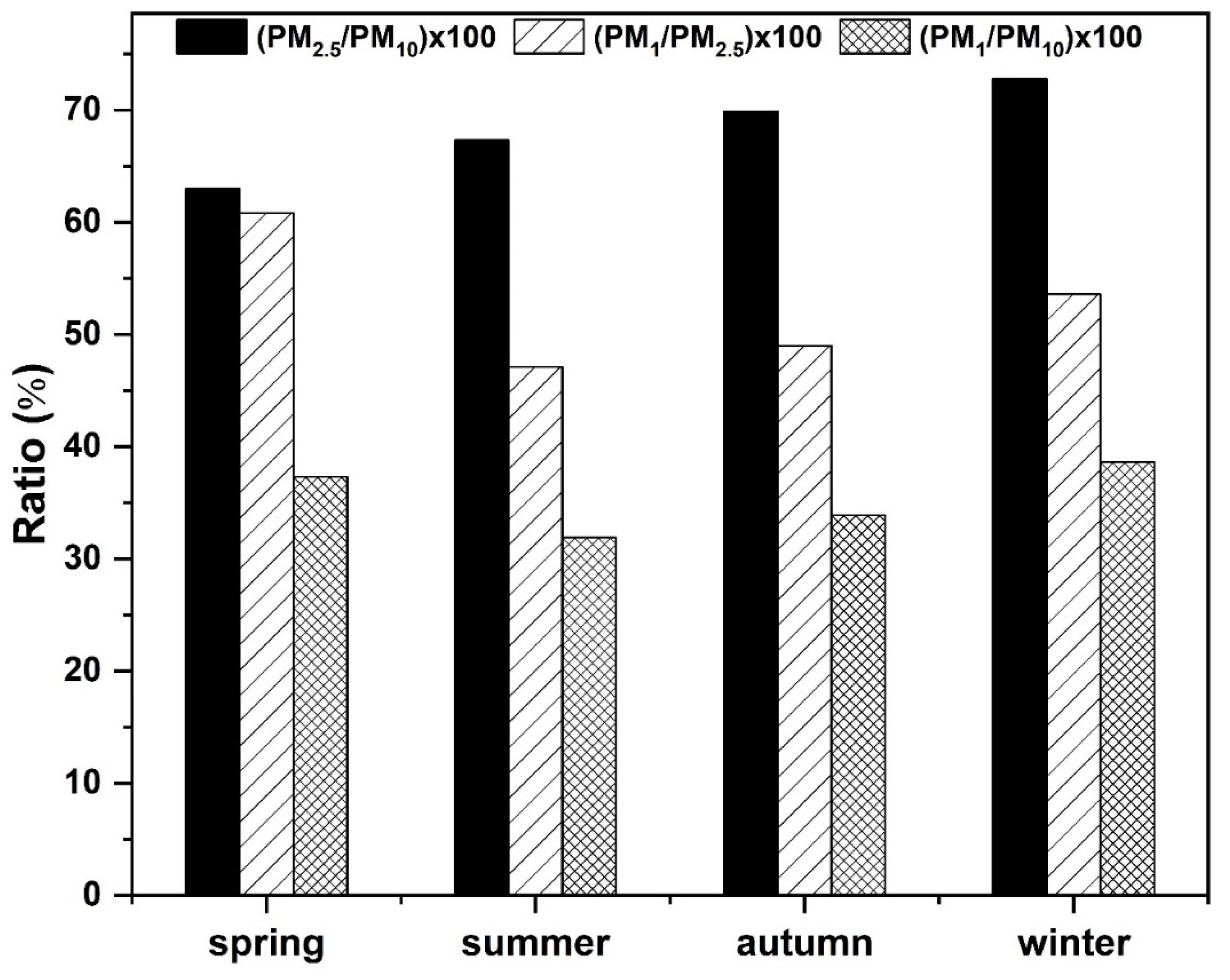
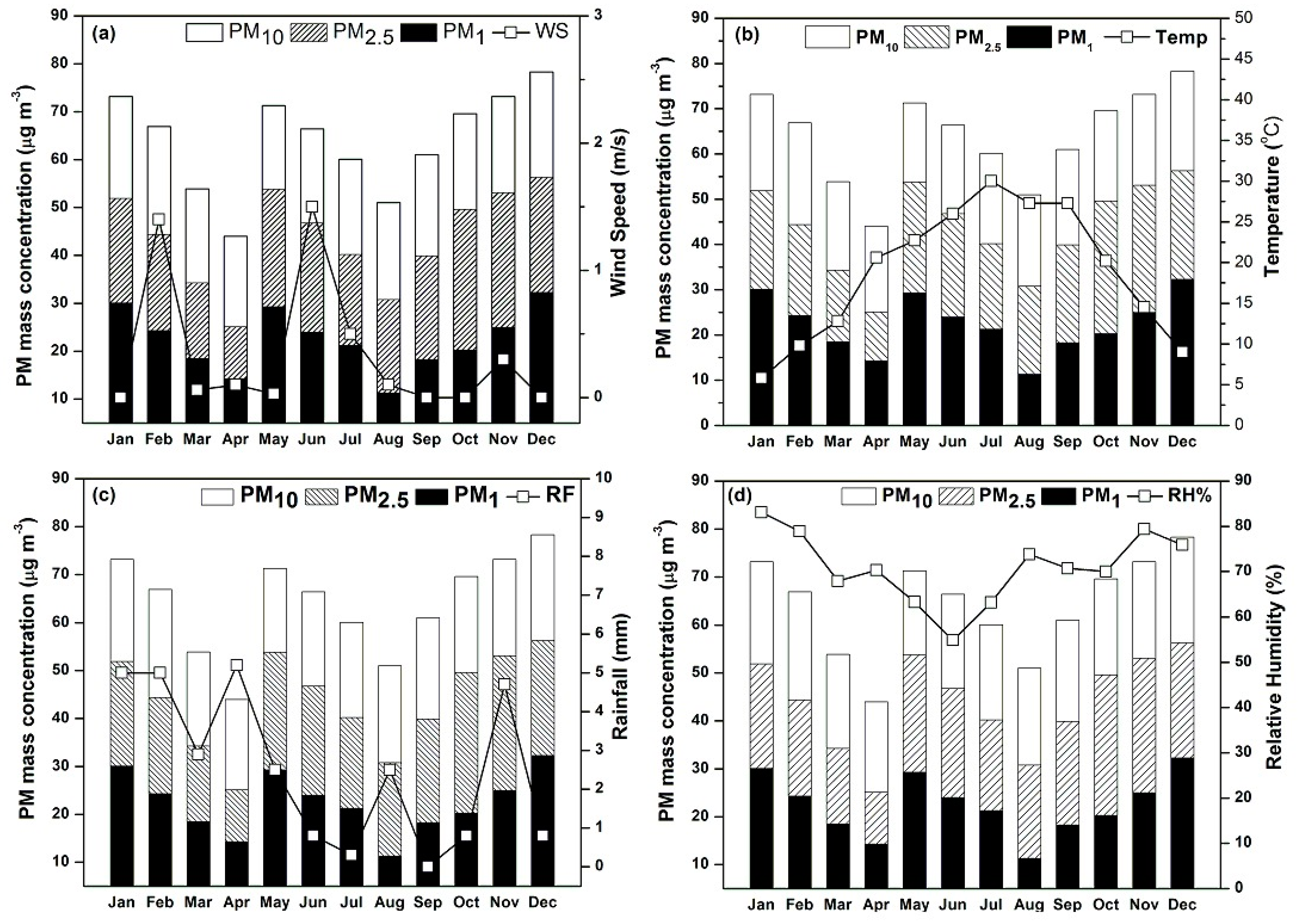
| PM10 | PM2.5 | PM1 | |
|---|---|---|---|
| Wind speed | −0.34 NS | −0.39 NS | −0.41 * |
| Temperature | −0.69 ** | −0.71 ** | −0.74 ** |
| Rainfall | −0.63 * | −0.61 * | −0.59 NS |
| Relative humidity | −0.32 | −0.10 | −0.02 |
Publisher’s Note: MDPI stays neutral with regard to jurisdictional claims in published maps and institutional affiliations. |
© 2022 by the authors. Licensee MDPI, Basel, Switzerland. This article is an open access article distributed under the terms and conditions of the Creative Commons Attribution (CC BY) license (https://creativecommons.org/licenses/by/4.0/).
Share and Cite
Usman, F.; Zeb, B.; Alam, K.; Valipour, M.; Ditta, A.; Sorooshian, A.; Roy, R.; Ahmad, I.; Iqbal, R. Exploring the Mass Concentration of Particulate Matter and Its Relationship with Meteorological Parameters in the Hindu-Kush Range. Atmosphere 2022, 13, 1628. https://doi.org/10.3390/atmos13101628
Usman F, Zeb B, Alam K, Valipour M, Ditta A, Sorooshian A, Roy R, Ahmad I, Iqbal R. Exploring the Mass Concentration of Particulate Matter and Its Relationship with Meteorological Parameters in the Hindu-Kush Range. Atmosphere. 2022; 13(10):1628. https://doi.org/10.3390/atmos13101628
Chicago/Turabian StyleUsman, Farooq, Bahadar Zeb, Khan Alam, Mohammad Valipour, Allah Ditta, Armin Sorooshian, Rana Roy, Iftikhar Ahmad, and Rashid Iqbal. 2022. "Exploring the Mass Concentration of Particulate Matter and Its Relationship with Meteorological Parameters in the Hindu-Kush Range" Atmosphere 13, no. 10: 1628. https://doi.org/10.3390/atmos13101628







